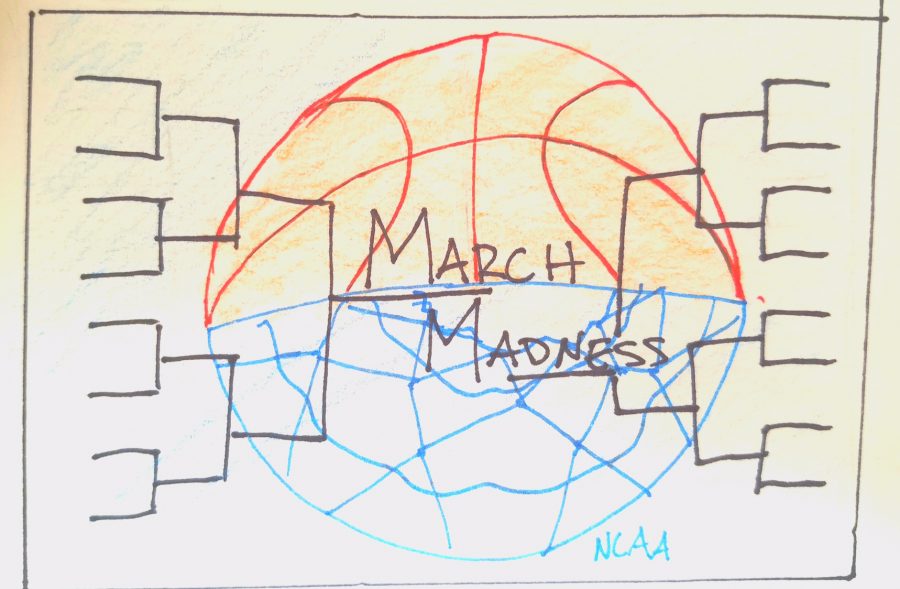March Madness: The Phenomenon
April 10, 2017
I was sitting in the middle of Buffalo Wild Wings, surrounded on all sides by diners and large screens, from which projected live showings of myriad games and sports. Deeply engrossed by the basket of dry rub wings in front of me, I took a while to realize or question why cheers around me seemed louder, larger, and more frequent than usual. Then I realized: it’s March.
For the uninitiated outsider, such as yours truly, the start of March heralds in an inexplicable, cult-like aura of mystery. Brackets are hastily brandished before being hurriedly tucked away out of sight, into backpacks and pockets. In study halls, with veins a-poppin’, students hunch nervously over phone screens and laptop screens, anxiously streaming live video.
Without fail, every March, March Madness, more officially and less appealingly known as the NCAA Division I Men’s Basketball Tournament, infects Ridge students with an itch to craft brackets, stream basketball games under the desk during class, and embark on the volatile emotional rollercoaster that follows a team’s win or loss.
At first glance, this phenomenon seems unexplainable. After all, March Madness is really just a basic tournament, one that features 68 college basketball teams that are in Division I of the National Collegiate Athletic Association (NCAA). The champions from the 32 Division I conferences are automatically entered into the tournament. A selection committee decides the 36 teams that will fill the remaining slots. Once the 68 slots have been filled, the 68 teams are divided into four regions, East, South, Midwest, and West, and then seeded, or ranked, from 1 to 16 in each region.
The 68 teams play each other in successive rounds, in which a pre-determined bracket dictates the next team a winning team faces. Rounds are charmingly and alliteratively named, with names such as “Sweet Sixteen,” “Elite Eight,” and finally, “Final Four.” The Final Four refers to the conglomeration of the top team from each of the aforementioned four regions, which compete against each other for the national championship.
Ultimately, perhaps the investment of the fans is what elevates March Madness from a typical sports tournament to an annual, national phenomenon. A common trademark of March Madness are the brackets: avid followers of March Madness often take the time to create their own brackets, predicting how the expansive tournament will unfold. Brackets can predict winning teams and final scores—basically, anything about a basketball game that can be quantified.
Collin Montag ‘17 believes, “March Madness is an exciting tradition because it’s a chance to pit yourself against your colleagues, family members, friends, and peers in something that’s partly grounded in how well you do your research and how well you know your teams, and also depends on a dash of luck here and there. Whether March Madness is good or bad, it still motivates people to watch [games] a lot more than they would otherwise, because they’re paying attention to their brackets.”
In general, the allure of sports lies within a combination of its adrenaline-inducing, fast-paced action and fans’ deep-rooted dedications to their teams. However, March Madness introduces another attractive factor through the massive volume of money that changes hands over the course of its games.
Indeed, for sports fans, the most they can normally do is spectate: only the players and the coaches can directly dictate what occurs in a game. With March Madness and its brackets, however, basketball fans have a chance to exercise their abilities instead of simply watching from the sidelines. That is, March Madness not only involves team pride, but also personal pride—an accurate bracket is something that depends upon its creator, not upon the game played or the teams playing. By becoming a phenomenon that directly involves and interacts with those who normally spectate, March Madness manages to become all the more popular.
In the end, sports is a communal experience, and March Madness only further unifies those who participate in it. For instance, Ashley Yang ’17 remarks, “I’m not an avid sports fan, so I sort of don’t understand why March Madness is so important. But I guess there is this sense of fun and community that comes with March Madness. You and your friends compete with each other to see whose guesses will actually be correct.”
After all, March Madness—with its varied games, outcomes, and upsets—offers common grounds upon which people with no other interests in common can commiserate and bond. And that was something that even I, who possessed little-to- no knowledge of college basketball as I sat amid cheering, gasps, curses, and whoops in Buffalo Wild Wings, could understand.

